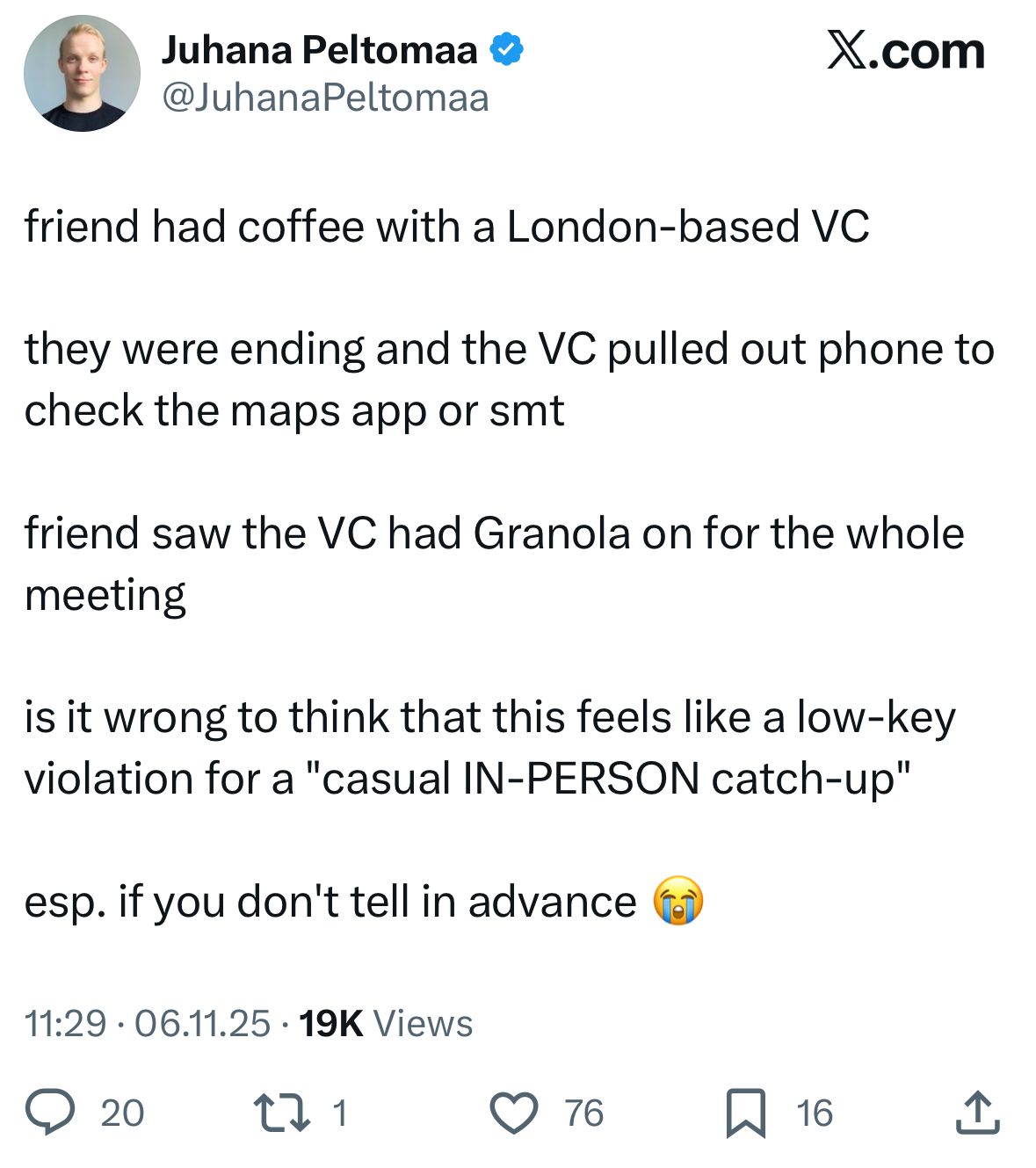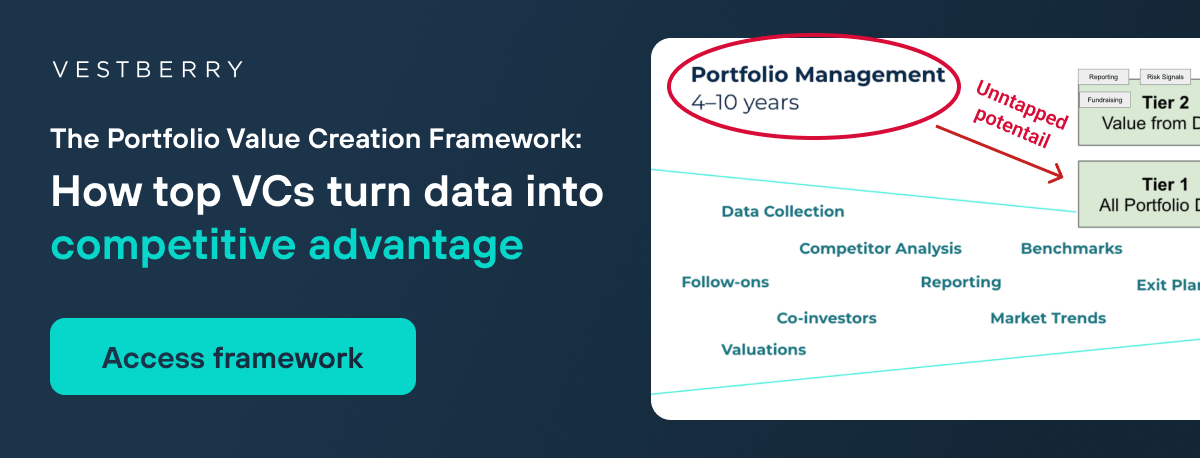👋 Hi, I’m Andre and welcome to my newsletter Data Driven VC which is all about becoming a better investor with Data & AI. ICYMI, check out some of our most read episodes:
Brought to you by VESTBERRY - Portfolio Intelligence Platform for Data Driven VCs
After engaging with over 2,000 VC funds, we identified the biggest missed opportunity: utilizing portfolio data to drive value post-investment. VCs hold companies for 4–10 years, making critical decisions throughout, yet most lack a systematic approach. Our framework shows you how to build the portfolio data foundation and use it to drive value.
51% of professionals take individual meeting notes - a number that has remained remarkably stable over the years. But within that group, a quiet revolution is underway: one in five now rely on recordings and AI-driven transcriptions to capture their conversations. This share is skyrocketing, with VC investors likely at the forefront of this shift.
For investors, meetings are the heartbeat of the job. Founders, co-investors, LPs, and ecosystem partners - every week brings dozens of conversations, each filled with insights, opportunities, and follow-ups. Proper documentation is essential to make sense of it all.
How Note-Taking Has Changed
When I first got into VC back in 2017, building a note-taking workflow was one of my earliest habits - a lifeline for managing the constant flow of information.
Having lost too many physical notebooks over the years, I’ve been digital by default ever since. I tested pretty much everything - from OneNote to Evernote and Notion - but eventually landed on Apple Notes. It works online and offline, syncs seamlessly across devices, and, most importantly, stays out of the way. Simplicity often wins when it comes to productivity.
For calls, taking notes on the go was easy enough without breaking the conversation flow. But for in-person meetings, especially casual ones over coffee or lunch, it always felt awkward to pull out my laptop or phone. My workaround was to summarize key points right after - better than nothing, but inevitably, some details slipped through the cracks.
Then, about five years ago, COVID happened. Certainly not the fondest period to recall, but it did spark massive improvements in virtual meeting infrastructure such as Zoom, Teams, Google Meet, and beyond. Suddenly, we could squeeze in double or triple the number of meetings per day as travel times disappeared. And along with that shift came another breakthrough: the rise of AI-driven transcription tools like Otter, Fireflies, and more recently, Granola - as well as built-in options such as Gemini, Zoom Transcribe, or Teams Transcribe.
More meetings, all well documented.
Upgrade your subscription to access our premium content & join the Data Driven VC community
But here’s the twist: some of these tools join meetings as visible participants, signaling that everything is being recorded. Others, like Granola, operate quietly in the background, recording every word without an explicit announcement. It’s the next evolution that’s obviously more convenient but raises a key question..

The Ethics (and Etiquette) of AI Note-Taking
Where’s the line between convenience and consent?
On one hand, automatic transcription has become a massive productivity boost - a superpower for anyone who wants to stay present in conversations while keeping perfect records. On the other, recording someone without their knowledge (even for harmless note-taking purposes) raises legitimate concerns about transparency and privacy.
Investors, in particular, walk a fine line here. Founder meetings often include sensitive, sometimes confidential information. While AI notes make follow-ups easier, they also introduce potential trust and compliance risks if recordings aren’t disclosed or properly secured.
The question isn’t whether AI will become standard in note-taking - it already has. The real question is how we’ll use it responsibly.

Share this article with others who might benefit.
Best Practices for Ethical AI Note-Taking
So how can we balance efficiency with ethics? A few principles help:
#1 Internal vs external meetings
Internal: From an organizational standpoint, there’s little that speaks against recording internal meetings. It allows proper documentation, keeping everyone in the loop, participants to decide whether to join meetings or just read the recordings afterwards, leverage AI to spot duplications and contradictions, streamline workflows, and a lot more. It’s the best way to conserve organizational knowledge and recordings should be on per default.
External: Not every meeting needs to be recorded. Decide ahead if this is a casual, friendly catch up or a meeting where you expect relevant information to be exchanged.
#2 Transparency first
If a meeting is being recorded or transcribed, make it explicit by asking - and not by having your AI bot in the waiting room, implicitly putting pressure on your counterpart. Or even worse, using a hidden tools without your counterpart recognizing it. I’m well aware that some countries do not require consent, while others do. Whatever the local situation, I personally prefer transparency and want to avoid privacy surprises at all cost.
#3 Use professional and secure tools
Assuming you always ask for consent (and also get it), then don’t bring your entourage of AI bots with you to the call but use subtle solutions that run local. Choose platforms that comply with data privacy standards (e.g., GDPR) and store transcriptions securely. Sensitive conversations deserve sensitive handling.

#4 Separate signal from noise
Just because AI can transcribe everything doesn’t mean every word is worth keeping. Summarizing key takeaways - ideally assisted by AI - is often more valuable than raw transcripts. Make sure to double-check every transcript before pushing it to your CRM. Details about the last weekend don’t necessarily belong there.
#5 Stay human
AI should augment, not replace, memory and judgment. Notes are only as useful as the insights you extract from them. Don’t forget to apply your own thinking.
The Future of Meeting Memory
We’re moving toward a world of frictionless recall.
While my habit of taking notes in every meeting hasn’t changed, the how and level of detail certainly have. Tools like Granola, Ray-Ban Meta Wayfarer glasses, or even the upcoming OpenAI Pin are blurring the lines between note-taking and full-scale recording. Whatever the device, visible or discreet, it’s becoming safe to assume that every meeting could be recorded.

For me, that leads to two simple rules:
If you want to record, ask for explicit consent
If you don’t want to be recorded, ask for explicit refusal
Stay driven,
Andre


